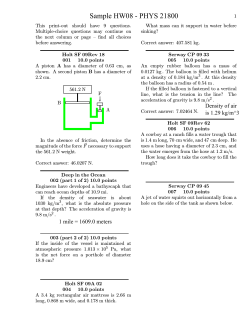
Ramberg-Osgood Convertor User Manual TM
Ramberg-Osgood ConvertorTM User Manual Ramberg-Osgood ConvertorTM User Manual Version: 1.0.3 Copyright © 2010-2014 offpipeassistant.com. All Rights Reserved. Ramberg-Osgood ConvertorTM User Manual INDEX 1 FUNCTION ................................................................................................................. 1 2 INSTALLATION........................................................................................................... 3 3 HOW TO USE............................................................................................................. 4 4 THEORY INSTRUCTION ........................................................................................... 9 5 FAULT MESSAGES & NOTES ................................................................................. 11 6 TECHNICAL SUPPORT & AUTHORIZATION .......................................................... 12 Ramberg-Osgood ConvertorTM User Manual 1 FUNCTION Ramberg-Osgood ConvertorTM is a sub software of OFFPIPE AssistantTM which is developed to transform Ramberg-Osgood equation from stress-strain form to moment-curvature form for offshore pipelines. Users can also apply this software to pipe with any type of materials and dimensions by input custom parameters. Ramberg-Osgood equation in stress-strain form is: ⎛ σ ⎞ ε σ = + α⎜ ⎟ ⎜σ ⎟ εy σ y ⎝ y⎠ β (1.1) in which σ y = SMYS (1.2) σy E (1.3) εy = where ε Strain; εy Nominal yield strain; σ Stress; σy Nominal yield stress; α Ramberg-Osgood parameter in stress-strain form; β Ramberg-Osgood parameter in stress-strain form; SMYS Specified minimum yield strength; E Elastic modulus. In some commercial offshore pipeline software, such as OFFPIPETM, it is often required to provide Ramberg-Osgood equation in moment-curvature form: ⎛M ⎞ K M ⎟ = + A⎜ ⎜M ⎟ K y My y ⎝ ⎠ B (1.4) in which 2 × SMYS ED 2 × SMYS × I My = D Ky = I= π (D 4 − (D − 2t )4 ) 64 where 1 (1.5) (1.6) (1.7) Ramberg-Osgood ConvertorTM User Manual K Curvature; Ky Nominal yield curvature; M Moment; My Nominal yield moment; A Ramberg-Osgood parameter in moment-curvature form; B Ramberg-Osgood parameter in moment-curvature form; I The area moment of inertia; D Outside diameter of the pipeline; t Wall thickness of the pipeline. Ramberg-Osgood ConvertorTM outputs A, B, Ky, My with input of SMYS, α, β, E, D, t. Ramberg-Osgood ConvertorTM has several features as following: 1. Easy and standard input A range of offshore pipeline steel types, API standard pipe sizes (OD in inches) and wall thicknesses from API "Specification for Line Pipe" (2000) are provided in the software, which can be input by simply clicking on the down arrow. The relevant yield stresses, Ramberg-Osgood parameters in stress-strain form, elastic modulus and outside diameters then appear in the appropriate boxes. Users can also input custom parameters for special pipelines. 2. Rapid and precise transform For any input, the transform will be completed in several seconds. 212 integration points are adopted to integrate the cross section of pipelines and 27 data points are adopted to fit the Ramberg-Osgood parameters in moment-curvature form. 3. Multiple pipe layers supported Multiple pipe layers input is supported by Ramberg-Osgood ConvertorTM. Users can input 5 pipe layers at most. 2 Ramberg-Osgood ConvertorTM User Manual 2 INSTALLATION To start to use Ramberg-Osgood ConvertorTM, please: 1. Insert the installation CD into the CD-ROM drive, or unzip the installation pack file. 2. Copy “Ramberg-Osgood Convertor” folder in root directory of installation CD or installation pack file to hard disk of your PC. 3. Insert the attached hard lock into one of USB port in your PC. 4. Double click “Ramberg-Osgood Convertor.exe” icon in the folder to start the software. Ramberg-Osgood ConvertorTM runs on PC with Windows XP or Windows 7. 3 Ramberg-Osgood ConvertorTM User Manual 3 HOW TO USE Brief procedure of running Ramberg-Osgood ConvertorTM is shown as following: 1. Input pipeline parameters (1) Click on the down arrow of combobox “Pipe Layer Number” in groupbox “Input” to select the number of pipe layer to be input, as shown in Fig. 3.1. At most 5 pipe layers can be specified. Several pipe layer properties input tabsheets will appear below corresponding to the number selected. Fig. 3.1 Select pipe layer number 4 Ramberg-Osgood ConvertorTM User Manual Fig. 3.2 Input strain limit (2) Specify maximum strain of the pipeline in “Strain Limit (%)” edit, as shown in Fig. 3.2. Calculation will be conducted below this limit. (3) Click on the down arrow of combobox “Steel Grade (API)” to select steel grade of pipeline, as shown in Fig. 3.3. Once steel grade specified, values of SMYS, α, β, and E will be specified automatically and shown in edits below. Users can also select “Custom” to input their own parameters in edits below. 5 Ramberg-Osgood ConvertorTM User Manual Fig. 3.3 Select steel grade Fig. 3.4 Select pipeline dimension (4) Click on the down arrow of combobox “Dimension” to select pipeline dimension measured by inch, as shown in Fig. 3.4. For example, “OD_56” means the nominal outside diameter of the pipeline is 56 inches, and so on. Once pipeline dimension specified, outside 6 Ramberg-Osgood ConvertorTM User Manual diameter of the pipeline measured by mm will be specified automatically and shown in “Outside Diameter (mm)” edit below. Users can also select “Custom” to input their own outside diameter in “Outside Diameter (mm)” edit below. (5) Click on the down arrow of combobox “Wall Thickness (mm)” to select pipeline wall thickness, as shown in Fig. 3.5. These thicknesses are automatically generated according to the dimension users specified. Users can also input their own wall thickness in combobox “Wall Thickness (mm)” directly. Fig. 3.5 Select pipeline wall thickness 7 Ramberg-Osgood ConvertorTM User Manual Fig. 3.6 Run the transform (6) Parameters in step (3)~(5) should be input for other pipe layers. Users can input properties of different pipe layers in any sequence. 2. Run the transform Click button “Run” to execute the transform. The progressbar in the most below of the window will show the progress of transform. When completed, values of A, B, Ky, My will show in groupbox “Output – Ramberg-Osgood Parameters”, and Ramberg-Osgood curve will display in the chart in the right side of the window. Click the checkbox below to view M/My vs K/Ky. 8 Ramberg-Osgood ConvertorTM User Manual 4 THEORY INSTRUCTION 1. Determination of A As shown in Fig. 3.7, when M=My, there is A= K −1 Ky (4.1) Fig. 4.1 Determination of A Now it is just need to get K corresponding to M=My. The relationship between K and M is: KD 2 2x εx = εmax D εmax = (4.2) (4.3) According to equation (1.1) ⎛ σ ⎞ ε σ = + α⎜ ⎟ ⎜σ ⎟ εy σ y ⎝ y⎠ σx can be obtain from εx. Then there is β M = ∫ σ x xdA A Where εmax Maximum strain in the cross section corresponding to K; Strain in x position of the cross section; εx Stress in x position of the cross section; σx 9 (1.1) (4.4) Ramberg-Osgood ConvertorTM User Manual x Distance from neutral axis. Try different K, until M=My, then A can be determined from equation (4.1). Ramberg-Osgood ConvertorTM adopts 212 integration points to conduct the integration in equation (4.4). 2. Determination of B 2εlim D K lim = Ki = i K lim (i = 1,2,3...n ) n (4.5) (4.6) Where εlim Specified strain limit; Klim Curvature limit corresponding to εlim; n K-M data number. Then according to equation (4.2)~(4.4), there are n Mi. To obtain Ramberg-Osgood parameters A and B, apply Ramberg-Osgood equation in moment-curvature form to fit the n pairs of Ki-Mi data by least square method using Newton-Raphson iteration. Here n=27. However, in practice, the curve defined by the Ramberg-Osgood relationship is considered valid only up to the value of Kb. Curvatures beyond Kb represent strain states far in excess of those permitted. Kb = t D2 (4.7) So if Klim>Kb, then Klim=Kb. 3. Multiple pipe layers calculation When multiple pipe layers are specified by users, some variables should be treated specially. Ky Minimum one of Ky of all pipe layers; My Sum of My corresponding to Ky of all pipe layers; Kb Minimum one of Kb of all pipe layers. 10 Ramberg-Osgood ConvertorTM User Manual 5 FAULT MESSAGES & NOTES Some faults may be encountered by users are listed below: 1. A message window as Fig. 5.1 shows. Fig. 5.1 Fault message window How to solve: Make sure to fill all the blank comboboxes and edits before clicking “Run” button. 2. Software can not be started or run. How to solve: Please insert the attached hard lock into one of USB port in your PC. 11 Ramberg-Osgood ConvertorTM User Manual 6 TECHNICAL SUPPORT & AUTHORIZATION For technical support and authorization of Ramberg-Osgood ConvertorTM, please visit: http://www.offpipeassistant.com or contact: support@offpipeassistant.com 12
© Copyright 2025











